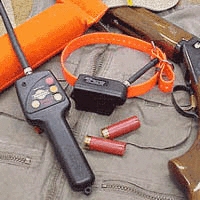Shock Collars are Cruel to Dogs
As a springer spaniel named Felicity's Diamond Jim pranced to victory at the recent Westminster Kennel Club dog show at New York's Madison Square Gardens, I was thinking of another springer spaniel named Minnie whose life is quite different from the champ's. Minnie, along with a boxer named Bailey, escaped last month from their yard and fell through the thin ice covering a pond in Connecticut. They might have died in the frigid, muddy water had a neighbor not heard Bailey's frantic barking. An intrepid firefighter braved the icy water and rescued the dogs.
The dogs' brush with death was the result of an invisible fence, which works by administering shocks to dogs via an electronic collar when they approach a boundary. These "fences" and shock collars are a disaster waiting to happen.
They can go haywire and administer constant shocks or deliver no shocks at all when the batteries go dead. Dogs have reportedly suffered serious burns when the collars malfunctioned or got wet. Some dogs may dash through the barrier chasing a squirrel and then become trapped outside, afraid to cross back into their own yards.
Shock collars aren't just unreliable - they also hurt like the devil. At least that's the verdict of people who have actually tested the collars on themselves. Michigan resident Jason Mitchell set up a Web site to show how much electronic collars hurt. He compared the pain of the shock collar to "a mass of black flies biting you all at once." Last July, people who visited Mitchell's Web site could pay either to shock him or to spare him from a shock, with the results broadcast via online video. The fee went higher as the setting on the collar went higher. Mitchell refused to go above level 4 - the collar's highest setting is level 7 - because he said higher settings produced "painful after-effects." Mitchell generously donated some of the money that he raised to the local humane society.
Shock collars are currently under fire in the U.K., where the Kennel Club and the Association of Pet Dog Trainers are calling for a ban. When the Kennel Club asked members of Parliament (MPs) to test the collars on themselves, they were shocked - literally - at how painful they were. "That really hurt!" said MP Eleanor Laing. "That is positively cruel and I am disgusted." MP Richard Benyon pronounced the experience "horrible… I definitely would not use one."
Humans can tell us that jolting themselves in the neck isn't a pleasant experience, but what about dogs? A study conducted at the University of Utrecht on German shepherds (not exactly the wimpiest of breeds) found that many of the dogs reacted to shocks with "high pitched yelps, barks and squeals." Indications of stress, such as lowered body posture, continued long after the shocks were administered. Some dogs who had been shocked became fearful merely by being in the presence of their handlers.
People who have used shock collars report that their dogs developed unexpected behaviors in response to being zapped. One dog became fearful of leaving the house, knowing that a painful jolt awaited him outside. Another developed aggression at passing joggers, thinking that they were the ones delivering the shock. One dog whose owner used a shock collar in obedience class became fearful of large groups of people and dogs.
Electronic training devices are simultaneously the laziest and most painful ways to train your dog. No one should entrust his or her best friend's safety to a battery-operated barrier. There is simply no substitute for proper training using positive reinforcement. It may take a little bit more time, but you'll end up with a happier companion who is eager to please instead of being afraid not to.
By Alisa Mullins, a senior editor with People for the Ethical Treatment of Animals (PETA), 501 Front St., Norfolk, VA 23510; www.HelpingAnimals.com.
